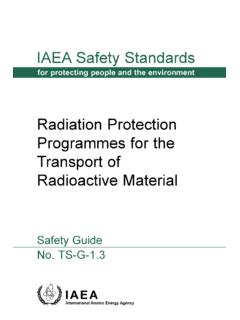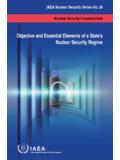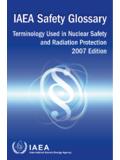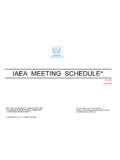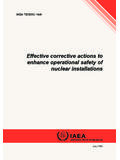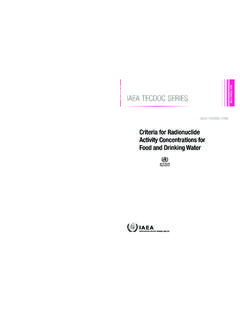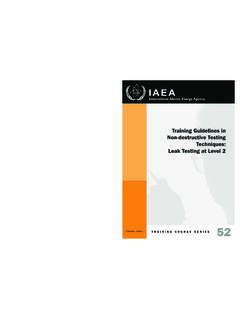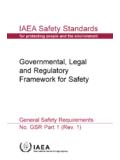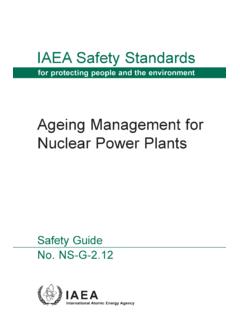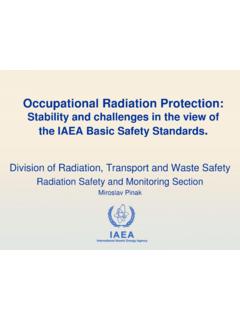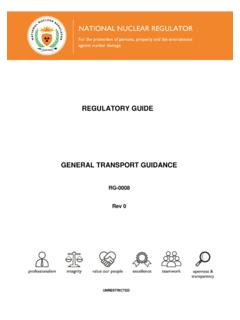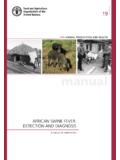Transcription of RADIATION PROTECTION AND SAFETY IN …
1 RADIATION PROTECTIONAND SAFETYIN INDUSTRIAL RADIOGRAPHYThe following States are Members of the international atomic energy agency :AFGHANISTANALBANIAALGERIAARGENTIN AARMENIAAUSTRALIAAUSTRIABANGLADESHBELARU SBELGIUMBOLIVIABOSNIA ANDHERZEGOVINABRAZILBULGARIABURKINA FASOCAMBODIACAMEROONCANADACHILECHINACOLO MBIACOSTA RICACOTE D IVOIRECROATIACUBACYPRUSCZECH REPUBLICDEMOCRATIC REPUBLICOF THE CONGODENMARKDOMINICAN REPUBLICECUADOREGYPTEL SALVADORESTONIAETHIOPIAFINLANDFRANCEGABO NGEORGIAGERMANYGHANAGREECEGUATEMALAHAITI HOLY SEEHUNGARYICELANDINDIAINDONESIAIRAN, ISLAMIC REPUBLIC OF IRAQIRELANDISRAELITALYJAMAICAJAPANJORDAN KAZAKHSTANKENYAKOREA, REPUBLIC OFKUWAITLATVIALEBANONLIBERIALIBYAN ARAB JAMAHIRIYALIECHTENSTEINLITHUANIALUXEMBOU RGMADAGASCARMALAYSIAMALIMALTAMARSHALL ISLANDSMAURITIUSMEXICOMONACOMONGOLIAMORO CCOMYANMARNAMIBIANETHERLANDSNEW ZEALANDNICARAGUANIGERNIGERIANORWAYPAKIST ANPANAMAPARAGUAYPERUPHILIPPINESPOLANDPOR TUGALQATARREPUBLIC OF MOLDOVAROMANIARUSSIAN FEDERATIONSAUDI ARABIASENEGALSIERRA LEONESINGAPORESLOVAKIASLOVENIASOUTH AFRICASPAINSRI LANKASUDANSWEDENSWITZERLANDSYRIAN ARAB REPUBLICTHAILANDTHE FORMER YUGOSLAV REPUBLIC OF MACEDONIATUNISIATURKEYUGANDAUKRAINEUNITE D ARAB EMIRATESUNITED KINGDOM OF GREAT BRITAIN AND NORTHERN IRELANDUNITED REPUBLICOF TANZANIAUNITED STATESOF AMERICAURUGUAYUZBEKISTANVENEZUELAVIET
2 NAMYEMENYUGOSLAVIAZAMBIAZIMBABWEThe agency s Statute was approved on 23 October 1956 by the Conference on the Statute of theIAEA held at United Nations Headquarters, New York; it entered into force on 29 July 1957. TheHeadquarters of the agency are situated in Vienna. Its principal objective is to accelerate and enlarge thecontribution of atomic energy to peace, health and prosperity throughout the world . IAEA, 1999 Permission to reproduce or translate the information contained in this publication may beobtained by writing to the international atomic energy agency , Wagramer Strasse 5, Box 100,A-1400 Vienna, by the IAEA in AustriaJanuary 1999 STI/PUB/1066 RADIATION PROTECTIONAND SAFETYIN INDUSTRIAL RADIOGRAPHYSAFETY REPORTS SERIES No.
3 13 international atomic energy AGENCYVIENNA, 1999 VIC Library Cataloguing in Publication DataRadiation PROTECTION and SAFETY in industrial radiography. Vienna : international atomic energy energy , ; 24 cm. ( SAFETY reports series, ISSN 1020 6450; no. 13)STI/PUB/1066 ISBN 92 0 100399 4 Includes bibliographical Radiography, Industrial SAFETY international AtomicEnergy 00214 FOREWORDThe use of ionizing RADIATION , particularly in medicine and industry, is growingthroughout the world, with further expansion likely as technical developments resultfrom research. One of the longest established applications of ionizing RADIATION isindustrial radiography, which uses both X RADIATION and gamma RADIATION toinvestigate the integrity of equipment and structures.
4 Industrial radiography iswidespread in almost all Member States. It is indispensable to the quality assurancerequired in modern engineering practice and features in the work of multinationalcompanies and small businesses radiography is extremely versatile. The equipment required isrelatively inexpensive and simple to operate. It may be highly portable and capable ofbeing operated by a single worker in a wide range of different conditions, such as atremote construction sites, offshore locations and cross-country pipelines as well as incomplex fabrication facilities. The associated hazards demand that safe workingpractices be developed in order to minimize the potential exposure of radiographersand any other persons who may be in the vicinity of the work.
5 The use of shieldedenclosures (fixed facilities), with effective SAFETY devices, significantly reduces anyradiation exposures arising from the demands and rewards of industrial radiography, the ready availability of theessential equipment, the wide range of working conditions and the fact that thetechniques employed usually involve the routine manipulation and exposure ofpowerful gamma emitting sources and X ray machines have all been identified ascontributory to the likelihood of accidents. Even in Member States with highlydeveloped regulatory infrastructures, industrial radiographers, on average, receiveradiation doses that exceed those of other occupationally exposed workers, andindividual industrial radiographers are the most likely group of workers to receivedoses approaching relevant dose limits.
6 RADIATION PROTECTION and SAFETY in industrialradiography is thus of great importance in both developed and developing SAFETY Report summarizes good and current state of the art practices inindustrial radiography and provides technical advice on RADIATION PROTECTION andsafety. It contains information for Regulatory Authorities, operating organizations,workers, equipment manufacturers and client organizations, with the intention ofexplaining their responsibilities and means to enhance RADIATION PROTECTION and safetyin industrial NOTEA lthough great care has been taken to maintain the accuracy of information containedin this publication, neither the IAEA nor its Member States assume any responsibility forconsequences which may arise from its use of particular designations of countries or territories does not imply anyjudgement by the publisher, the IAEA.
7 As to the legal status of such countries or territories, oftheir authorities and institutions or of the delimitation of their mention of names of specific companies or products (whether or not indicated asregistered) does not imply any intention to infringe proprietary rights, nor should it beconstrued as an endorsement or recommendation on the part of the .. Background .. Objective .. Scope .. Structure .. OF RADIATION PROTECTION AND SAFETY .. RESPONSIBILITIES .. Regulatory Authority .. The operating organization .. Industrial radiographer/worker .. The manufacturers and suppliers .. The client .. OF EXPOSURE DEVICES.
8 Gamma radiography sources and containers .. X ray radiography equipment .. Accelerators .. Underwater radiography equipment .. Pipe crawler equipment .. Real time radiography .. Neutron radiography .. AND USE OF SHIELDED ENCLOSURES(FIXED FACILITIES) .. Enclosure design and use .. Shielding design for a shielded enclosure .. Control of exposure in shielded enclosures .. Operating procedures for shielded enclosures .. RADIOGRAPHY PROCEDURES .. Boundary of controlled area .. Shielding .. Administrative arrangements .. Monitoring .. Additional precautions for gamma radiography .. Additional precautions for X radiography including use ofaccelerators.
9 Additional precautions for underwater radiography .. Additional precautions for pipeline crawlers ..457. STORAGE, MOVEMENT AND TRANSPORT OF RADIOGRAPHICSOURCES AND EXPOSURE DEVICES .. Storage of sources .. Movement and transport of sources ..468. EMERGENCY RESPONSE PLANNING .. Emergencies resulting in exposures .. Emergency planning and preparedness .. Specific emergency procedures .. Accident notification and report ..55 REFERENCES ..57 GLOSSARY ..59 CONTRIBUTORS TO DRAFTING AND REVIEW ..6111. BACKGROUNDR adiography is of vital importance in non-destructive testing. Radiographyensures the integrity of equipment and structures such as vessels, pipes, welded joints,castings and other devices.
10 The integrity of this equipment affects not only the safetyand quality of the products used by workers, but also the SAFETY and quality of theenvironment for workers and the public at SAFETY record of over 40 years of application of ionizing RADIATION is verygood. In particular, radiography can be performed so as to pose a negligible risk onthe public and with sufficiently low occupational RADIATION exposure so as to pose noundue radiological risk on the , experience has also shown examples of bad practice. Radiographyproduces high dose rates so that a person accidentally exposed to the primary beamor in close contact with an unshielded source might within minutes or even secondsreceive a dose that results in injury.
